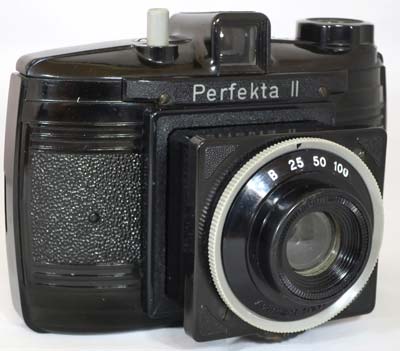Rheinmetall Perfekta II
Specification

| Manufacturer | : | VEB Mechanik Büromaschinenwerk Rheinmetall |
|---|---|---|
| Produced | : | 1954 |
| Classification | : | Medium Format |
| Body Type | : | Extending Body |
| Construction | : | Bakelite |
| Film Type | : | 120 |
| Film Width | : | 62mm |
| Image Size | : | 6 x 6 cm |
| No. of Images | : | 12 |
| Lens Type | : | Achromat |
| Focal Length | : | 80mm |
| Focus Type | : | fixed |
| Focal Range | : | 8ft - Inf. |
| Aperture Type | : | Variable stops |
| Apertures | : | f/7.7, f/11, f/16 |
| Shutter Type | : | Leaf |
| Shutter Speeds | : | B, I(1/25, 1/50, 1/100s) |
| Size Open (w x h x d) | : | 130 x 95 x 90 mm |
| Size Closed (w x h x d) | : | 130 x 95 x 70 mm |
| Weight | : | 298g |
Art Deco Credentials
![]()
![]()
![]()
Noteworthy: Worth giving special attention
- Produced after the main Art Deco period.
- Bakelite body
- Curvilinear box body shape.
- Horizontal linear ribbing to body.
- Grey plastic highlights.
Description
The Perfekta II is one of the series of cameras that were produced in the German Democratic Republic after World War II. The widespread use of Bakelite reduced the price of the otherwise metal parts which were not easily affordable after the war. Rheinmetall was one of the largest German arms manufacturers before, during and after World War II. After the war they diversified to making cameras and other domestic products.
The camera is made of black Bakelite with grey highlights to the speed control, the red window and the shutter release. It has a curvilinear design with horizontal linear ribbing around the body. The camera is a good example of the persistence into the 1950s of the Streamline Moderne style which originated in the USA in the 1930s.
The Perfekta II is more rounded and compact than it's predecessor, with a lens housing that collapses into the body. It has an optical viewfinder. The achromatic objective lens has a decent aperture of f/7.7 that can be stopped down to f/11 and f/16. The stops are on a rotating blade that can be moved into place using a wheel under the lens of the camera.
The shutter is coupled to the film advance so that double exposure is avoided. The shutter has timed speeds of 1/25, 1/50 and 1/100 second plus 'B'. The speed is set with a knurled plastic rim around the lens housing. The shutter-release is on the top of the body and is linked to the film advance mechanism which excludes the possibility of double exposure.
The red window can be covered with a rotating metal blade which is controlled by a small wheel alongside. A PC flash connector is provided on the left hand side behind the lens plate. The camera has a tripod mount on the bottom.
The camera was also sold by Sears as the Tower 66P.
How to Use
This camera takes 120 film which is easily available. It supports instant(I) mode with a speeds of 1/25, 1/50 and 1/100 sec. It has three aperture settings of f/7.7, f/11 and f/16.
If you don't want to bother with an exposure meter, follow the guide shown. It is based on the 'Sunny 16' rule. Film is so forgiving and will produce acceptable results even when over-exposed by 2 or 3 stops or under-exposed by 1 stop.
The table shown assumes the shutter speed is about 1/50s.
The table also assumes that the sun is at least 30 degrees above the horizon - that's 10am - 5pm on a summers day in the UK.
Remember that the exposure guide in the manual may not be helpful as it is based on the use of old film with a low ISO value.
At lower shutter speeds, make sure you brace the camera against your body or something solid and press the shutter smoothly to avoid camera shake.
Using ISO 100/125 film
Exposure
Green=Good
Amber=Acceptable
Red=Not Acceptable
| Weather Conditions | Shadow Detail | Shutter Speed (s) | ||
|---|---|---|---|---|
| 1/25 | 1/50 | 1/100 | ||
 Sunny SunnySnow/Sand | Dark with sharp edges | f/16 (+3) | f/16 (+2) | f/16 (+1) |
 Sunny Sunny | Distinct | f/16 (+2) | f/16 (+1) | f/16 |
 Slight Overcast Slight Overcast | Soft around edges | f/16 (+1) | f/16 | f/11 |
 Overcast Overcast | Barely visible | f/16 | f/11 | f/7.7 |
 Heavy Overcast Heavy Overcast | None | f/11 | f/7.7 | f/7.7 (-1) |
 Open Shade Open Shade/Sunset | None | f/7.7 | f/7.7 (-1) | f/7.7 (-2) |